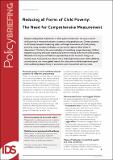| dc.contributor.author | Roelen, Keetie | |
| dc.date.accessioned | 2015-08-27T10:58:03Z | |
| dc.date.available | 2015-08-27T10:58:03Z | |
| dc.date.issued | 2015-08-26 | |
| dc.identifier.issn | 1479 974X | |
| dc.identifier.uri | https://opendocs.ids.ac.uk/opendocs/handle/20.500.12413/6880 | |
| dc.description.abstract | Despite widespread investments in child poverty reduction, the way in which child poverty is measured presents a narrow and partial picture. Current practice is still biased towards measuring static and single dimensions of child poverty, primarily using monetary indicators as a proxy to capture other areas of deprivation. This limits the understanding of underlying causes that keep children trapped in poverty and what needs to be done to reduce all forms of child poverty. Research in Ethiopia and Vietnam explored the extent to which living in an income-poor household also means that a child experiences poor child wellbeing and vice versa, and investigated reasons for why some children experience good child wellbeing despite living in an income-poor household and vice versa. | en |
| dc.language.iso | en | en |
| dc.publisher | Institute of Development Studies | en |
| dc.relation.ispartofseries | IDS Policy Briefing;98 | |
| dc.rights | Readers are encouraged to quote and reproduce material from issues of IDS Policy Briefings in their own publication. IDS requests due acknowledgement and quotes to be referenced as above. | en |
| dc.rights.uri | http://www.ids.ac.uk/files/dmfile/IDSOpenDocsStandardTermsOfUse.pdf | en |
| dc.subject | Children and Youth | en |
| dc.title | Reducing all Forms of Child Poverty: The Need for Comprehensive Measurement | en |
| dc.type | IDS Policy Briefing | en |
| dc.rights.holder | Institute of Development Studies | en |
| dc.identifier.team | Rural Futures | en |

